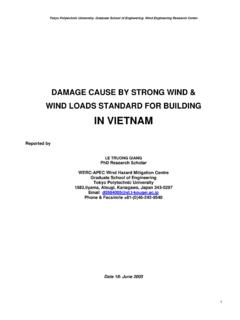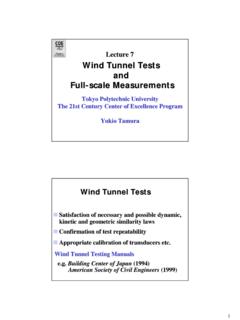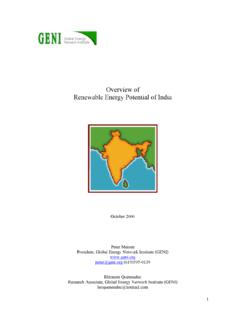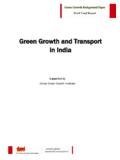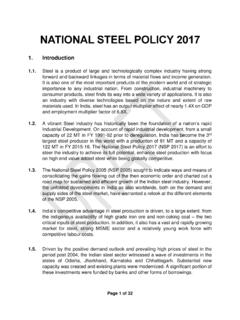Transcription of WIND ENERGY POTENTIAL ASSESSMENT IN NEPAL
1 wind ENERGY POTENTIAL ASSESSMENT IN NEPAL . Upreti a and Anil Shakyab a Department of Geology, Tribhuvan University, Ghantaghar, Kathmandu NEPAL b Department of Urban Development and Building Construction, Ministry of Physical Planning and Works ,Government of NEPAL , Babarmahal, Kathmandu, NEPAL ABSTRACT. NEPAL is a mountainous country with a high POTENTIAL for wind ENERGY . The data base is poor and wind data are not sufficient to make a realistic ASSESSMENT of the wind ENERGY . The extreme wind speed is as high as m/s, and 238 kW/m2 power density. The annual average ENERGY POTENTIAL is about MWh/m2.
2 The POTENTIAL area of wind power in the country is about 6074 sq. km with wind power density greater than 300 watt/m2. More than 3,000 MW of electricity could be generated at 5 MW per sq km. The commercially viable wind POTENTIAL of the country is estimated to be only about 448 MW. For calculating wind load on individual structural elements NBC 104 :1994 ( wind load) and the Indian standard IS :875 (part 3)1987 are followed. Every year storms kill many people, and destroy or damage properties worth hundreds of thousands of Dollars. KEY WORDS: wind ENERGY , NEPAL National Building Code NBS 104:1994 ( wind Load), wind hazard, disaster.
3 1. INTRODUCTION. NEPAL is a mountainous country lying along the middle part of the 2500 km long Himalayan range. It covers an area of about 147,181 sq km and is bounded by the northern latitudes 260 22' and 300 27' and the eastern longitudes 800 04' and 880 12'. Its length is about 885 km along the east-west direction and the width varies from 130 to 255 km. The country is under the influence of the strong SE monsoon climate. Winter is influenced also by a weak SW monsoon. Topography varies from nearly 100 m from msl at the northern edge of the Indo-Gangetic plains to high Himalayan ranges in the north with over 8000 m altitude.
4 NEPAL started collecting data on wind speed only from 1967. There are 40 wind measurement stations installed all over the country run under the Department of Hydrology and Meteorology; however, presently only 29 stations are properly running (Fig 1). They measure average monthly wind speed data at particular time of the day, maximum hourly gust and maximum gust. Even among these stations many provide only discontinuous data. Out of the 29 stations, 7 are in the higher Himalayan region, 11 in middle mountain region and 11 in the Terai plains in the south.
5 The average monthly wind speed data from 29 stations are presented in table 1 (DHM, 2008). However, the available database is inadequate both in terms of spatial distribution and duration for wind design structures. Modern wind design codes are based on the peak gust velocity averaged over a short interval of about 3 seconds with a 50 year returned period. The database is also insufficient to prepare the wind zone map. Fig. 1: Location of the 29 wind monitoring stations in NEPAL in 2009. The Solar and wind ENERGY Resource ASSESSMENT (SWERA) project run by the Alternative ENERGY Promotion Center (AEPC), provides a good overview on the wind resources ASSESSMENT on NEPAL .
6 Table 1: wind speed data for last three years (2005-2007) ( wind Speed in Km/hr). Maximum Maximum monthly Maximum Sr. Index monthly value monthly No. No. Station Elevation Latitude Longitude value 2005 2006 value 2007. 1 104 Dadeldhura 1848 m. 29 18 ' N 80 35 ' E Mahendra 2 105 Nagar 176 m. 29 02 ' N 80 13 ' E 3 209 Dhangadhi 170 m. 28 41' N 80 36' E 4 218 Dipayal 617 m. 29 15' N 80 57 ' E 5 303 Jumla 2300 m. 29 17 ' N 82 10 ' E 6 401 Pusmacamp 950 m. 28 53' N 81 15' E 7 405 Chisapani 225 m. 28 39' N 81 16' E 14 12 13. Birendra 8 406 Nagar 720 m. 28 36' N 81 37' E.
7 9 409 Khajura 190 m. 28 06' N 81 34' E 10 419 Sikta 195 m. 28 02' N 81 47' E 11 420 Nepalgunj 165 m. 28 06' N 81 40' E Bhairahawa 12 707 Agri. 120 m. 27 32' N 83 28' E 13 715 Kanchikot 1760 m. 27 56' N 83 09' E Pokhara 14 804 Airport 827 m. 28 13' N 84 00' E 15 811 Malepatan 856 m. 28 07' N 84 07' E 16 814 Lumle 1740 m. 28 18' N 83 48' E 17 911 Parwanipur 115 m 27 04' N 84 58' E 18 1029 Khumaltar 1350 m. 27 40' N 85 20' E 19 1030 Kathmandu 1337 m. 27 42' N 85 22' E Airport 20 1043 Nagarkot 2163 m. 27 42' N 85 31' E 21 1103 Jiri 2003 m. 27 38' N 86 14' E 22 1206 Okhaldhunga 1720 m.
8 27 19' N 86 30' E 23 1215 Lahan 138 m. 26 44' N 86 26' E 24 1304 Pakhribas 1680 m. 27 03' N 87 17' E 25 1307 Dhankuta 1210 m. 26 59' N 87 21' E Biratnagar 26 1319 Airport 72 m. 26 29' N 87 16' E 27 1320 Tarahara 200 m. 26 42' N 87 16' E 28 1405 Taplejung 1732 m. 27 21' N 87 40' E Ilam Tea 29 1407 Estate 1300 m. 26 55' N 87 54' E In NEPAL , the wind velocities in low altitude valleys are lower in magnitude than those in the high altitude valleys and mountain ridges. This is evident from data observed in Kathmandu (low values) and Kaligandaki valleys (high values).
9 NEPAL national building code NBC. 104 :1994 on wind load has divided the whole country into two regions: a. The lower plains and hills generally include the southern plains (Terai), Kathmandu Valley and areas generally below 3000 m altitude. Here the basic wind velocity of 47 m/s is adopted. b. The second zone lies above 3000 m. Here the basic wind velocity of 55 m/s has been adopted. Based on the available data, a wind zoning map of NEPAL has been prepared (Fig. 2). 2. NEPAL STANDARD ON wind LOAD. Though the database on wind velocity within NEPAL is not adequate, based on thee locally available data as well as the data from similar topographic zones of India; and also taking consideration of the Indian standard IS :875 (part 3)1987, code of practice for design loads (other than earthquake) for building and structures with amendments as set out on basic wind speed as (a) and (b), a NEPAL standard on wind load has been prepared.
10 According to IS: 875 (part 3) -1987: The design wind pressure at any height above mean sea level shall be obtained by the following relationship between wind pressure and wind velocity: Pz = (Vz)2. Where pz is design wind pressure in N/sq m at height Z and Vz is design wind velocity in m/sec at height Z. wind pressure and force on building The wind load on buildings shall be calculated for : (a) the building as a whole, (b). individual structural elements as roofs and walls (c) Individual cladding units including glazing and their fixings. The wind load acting normal to a surface is obtain by multiplying the areas of that surfaces or its appropriate portion by the pressure coefficient and the design pressure at the height of the surface from ground.
